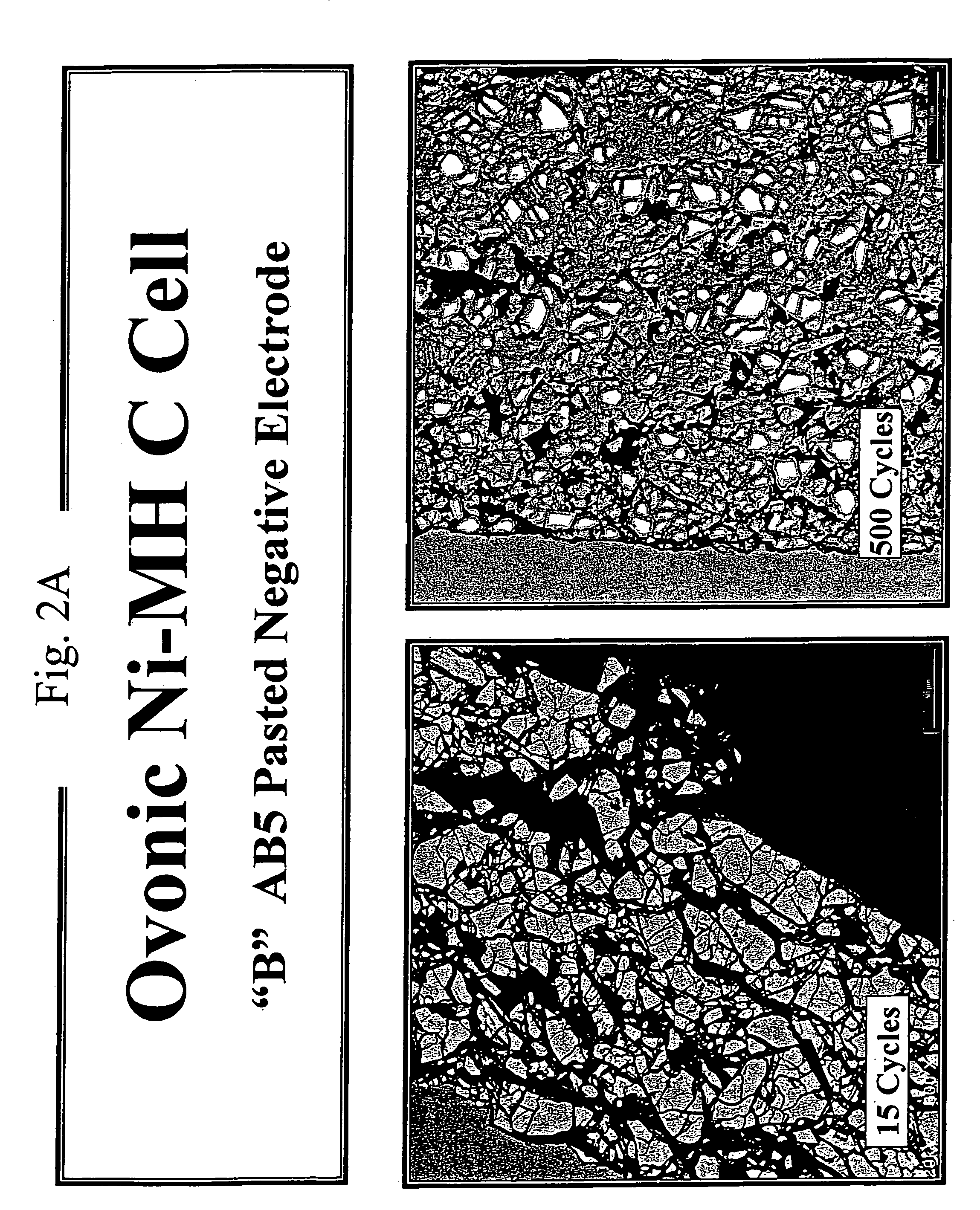Hydrogen storage alloys having improved cycle life and low temperature operating characteristics
a technology of low temperature operating characteristics and cycle life, applied in the direction of metal/metal-oxide/metal-hydroxide catalysts, cell components, physical/chemical process catalysts, etc., can solve the problems of increasing alloy cost, and achieve excellent low temperature power characteristics, excellent cycle life, and reduced co content
- Summary
- Abstract
- Description
- Claims
- Application Information
AI Technical Summary
Benefits of technology
Problems solved by technology
Method used
Image
Examples
example 1
[0090]The instant inventors compared the cycle life characteristics of batteries utilizing the B and B1 alloys. A standard commercial C-cell battery design was used in the comparison. The battery design included a negative electrode containing a hydrogen storage alloy, a nickel hydroxide positive electrode (OBC AP 52 HiZn), a fluorinated polypropylene / polyethylene separator (Freudenberg FS2226) and a 30% KOH electrolyte. Two batteries were used in the cycle life comparison. Each battery included a different hydrogen storage alloy as the active material in the negative electrode; the batteries were otherwise identical in construction. A roll compacted negative electrode design was used. One of the batteries used the B1 alloy as the active negative electrode material and the other battery used the B alloy. The cycle life of each of the batteries was tested to examine the stability of the battery capacity upon repeated cycles of charging and discharging. Charging of each battery was co...
example 2
[0093]In this example, factors that may be responsible for the reduced cycle life of the B1 alloy discussed in the experiments of EXAMPLE 1 are discussed. Elucidation of possible underlying causes is an important step in developing strategies for improving cycle life. In an effort to understand cycle life degradation, the instant inventors have probed the physical states of the B and B1 alloys at various points during a series of charge-discharge cycles. The physical state was probed by scanning electron microscopy and representative micrographs resulting from these studies are presented in FIGS. 2A and 2B. The micrographs depict the granularity of the B and B1 alloys upon repeated cycling to probe the effect of cycling on the particle size of the metal hydride electrode material. The micrograph images were obtained using a 20 kV electron beam probe and are shown at a magnification factor of 600×.
[0094]FIG. 2A shows the effect of cycling on the granularity of the B alloy as a functi...
example 3
[0097]The results presented in EXAMPLE 2 indicate that reducing the degree of pulverization upon cycling may improve the cycle life characteristics of metal hydride electrode materials. In this view, repeated absorption and desorption cycles work to breakdown the particles of the metal hydride material, thereby impairing efficacy. In order to optimize the search for new alloys that provide long cycle life, it is preferable to develop reliable and accurate criteria for determining the likelihood that a new composition will provide stable capacity over a large number of charge-discharge cycles. The ultimate test is a direct measurement of the cycle life. This test, unfortunately, is time consuming as it requires construction of electrodes, assemblage of a battery and repeated measurement of capacity over a large number of time-consuming cycles. In the cycle life test shown in FIG. 1, for example, it takes about one day to complete 5 cycles. Thus, 200 days are needed to complete 1000 c...
PUM
| Property | Measurement | Unit |
|---|---|---|
| volume fraction | aaaaa | aaaaa |
| volume fraction | aaaaa | aaaaa |
| volume fraction | aaaaa | aaaaa |
Abstract
Description
Claims
Application Information
 Login to View More
Login to View More - R&D
- Intellectual Property
- Life Sciences
- Materials
- Tech Scout
- Unparalleled Data Quality
- Higher Quality Content
- 60% Fewer Hallucinations
Browse by: Latest US Patents, China's latest patents, Technical Efficacy Thesaurus, Application Domain, Technology Topic, Popular Technical Reports.
© 2025 PatSnap. All rights reserved.Legal|Privacy policy|Modern Slavery Act Transparency Statement|Sitemap|About US| Contact US: help@patsnap.com



